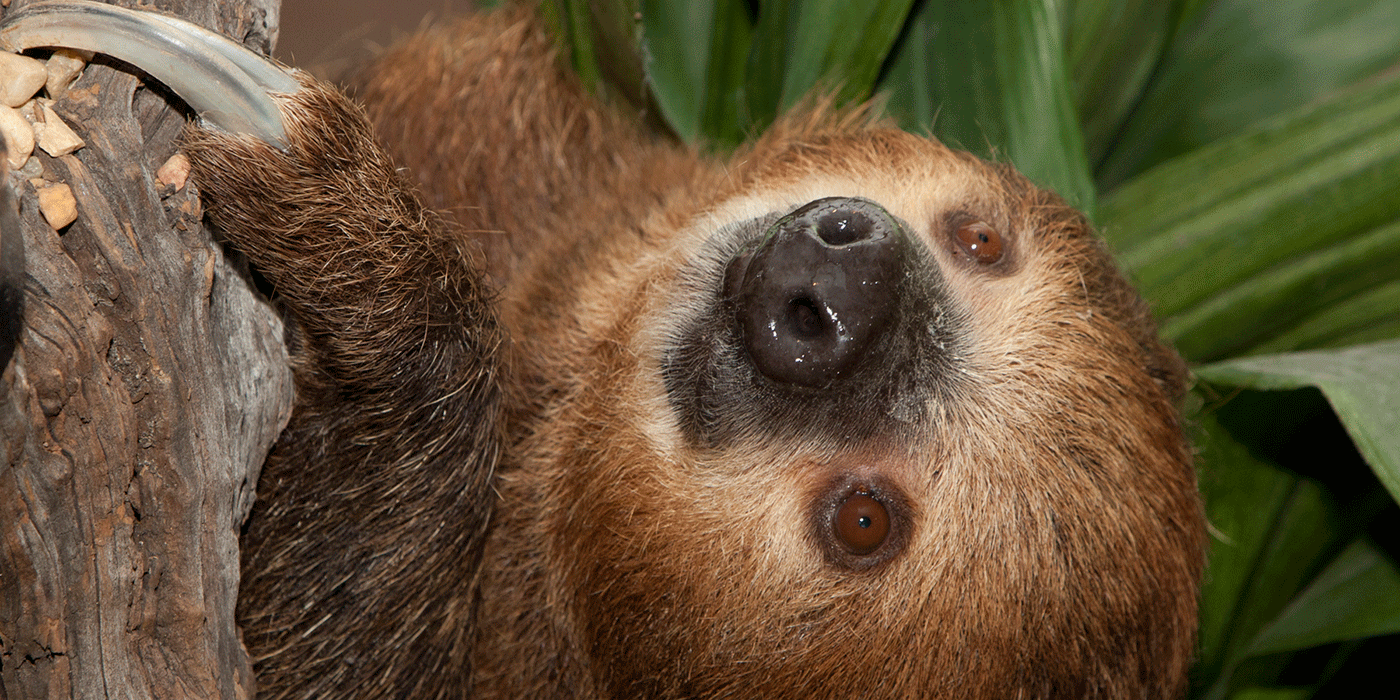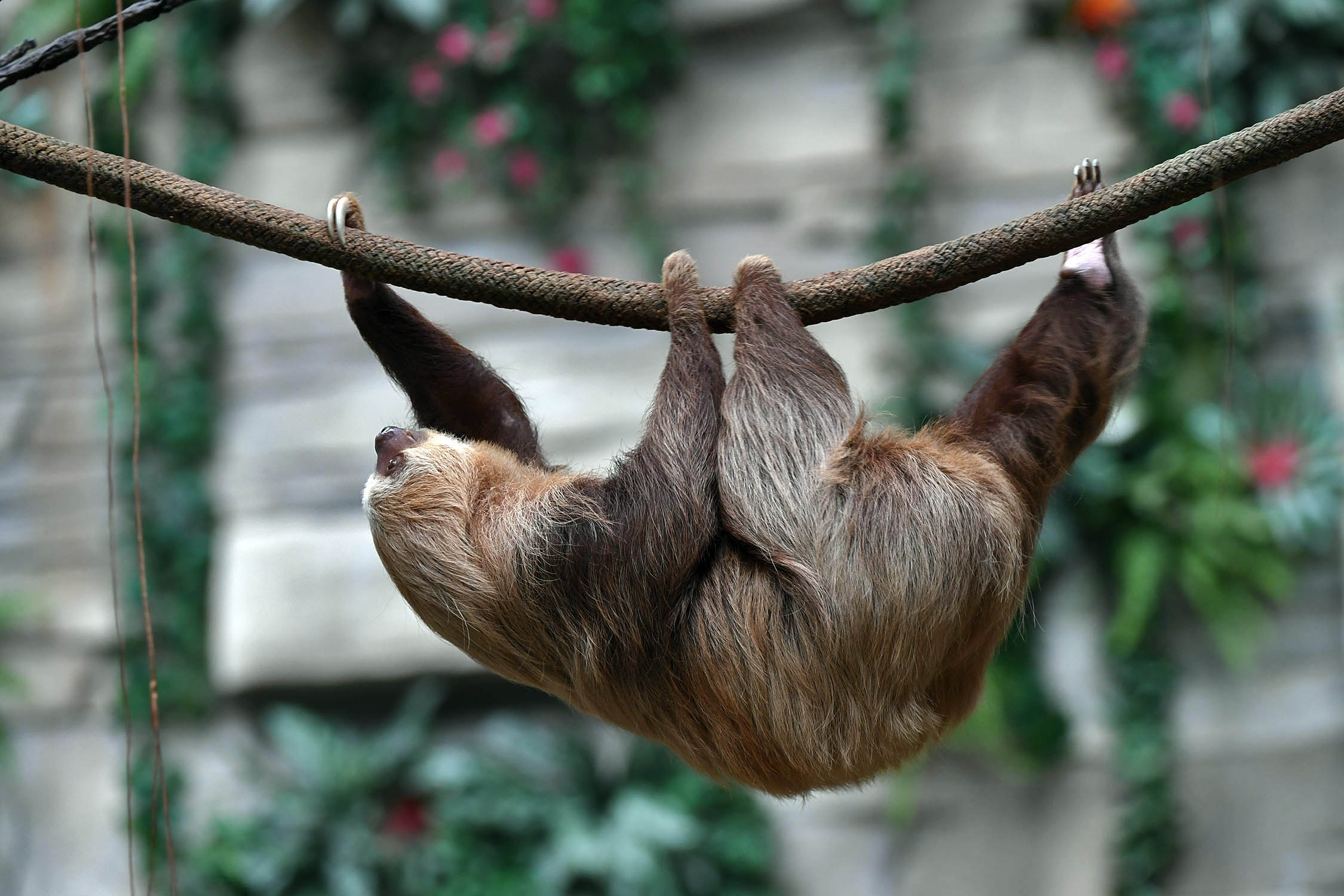How Sloths Slow
Oct. 20 is International Sloth Day. Impress your friends (and ace your next Buzzfeed quiz) with these fun facts about sloths.

- Sloths are medium-sized mammals that live in the Central and South American rainforests. The sloth got its name from its slow movement, it is not lazy, just slow-moving. The sloth is the slowest mammal on Earth. In total, there are six species of sloth. Sloths belong to the families ‘Megalonychidae’ and ‘Bradypodidae’, part of the.
- Ready, Steady, Slow! The Races is on to be crowned the supreme super slow sloth. Spin the spinner and draw the corresponding Snooze, Saunter or Sabotage cards in order to move yourself or your opponents. In this game the slowest sloth wins!
- Today is International Sloth Day, the worldwide holiday to celebrate these peaceful, slow-moving creatures. Sloths, or perezosos, are one of Costa Rica’s most iconic animals known for their friendly faces, which often have the appearance of welcoming smiles, and their tremendously slow way of life, which can even lead to moss growing on their backs.
- And isn’t it dangerous to be a slow moving creature in a jungle full of predators? Well, actually, the fact that sloths are slow actually serves as a defense. The jungles of Central and South America where sloths live are also home to some of the most fearful predators such as jaguars, panthers, ocelots, boa constrictors, anacondas and hawks.

Sloths’ slow movements and mainly nocturnal habits generally do not attract the attention of predators such as jaguars and harpy eagles. Normally, three-toed sloths are silent and docile, but if disturbed they can strike out furiously with the sharp foreclaws.
What is a sloth?
Sloths are the stars of memes and viral videos. They make us laugh, and they make celebrities cry. But these social media darlings have been around far longer than the internet. Millions of years ago, giant ground sloths the size of elephants roamed the planet. Some were nearly 20 feet long from snout to tail, with massive claws for pulling tree branches down to eat.
Today’s sloths are a little less intimidating. They max out at about 2.5 feet and weigh between 9 and 17 pounds (about the size of a small dog). They have coarse, brown fur, long limbs and curved claws for hanging tightly onto tree branches — the adaptation to upside-down tree living. And they’re one of the slowest-moving animals on earth!
There are two living families of sloths: two-toed sloths and three-toed sloths. Truth be told, all sloths have three toes on their back feet. But two-toed sloths only have two toes on their front feet, whereas three-toed sloths (you guessed it) have three. Two-toed sloths are also slightly bigger than their three-toed pals.
So, are sloths marsupials or primates?
Trick question. Sloths are mammals, but they aren’t primates or marsupials – though the groups do share some similarities. Koalas, for example, are marsupials that live in trees, eat leaves and have slow metabolisms. But sloths and koalas developed these traits independently of each other. The two aren’t closely related. Sloths actually belong to the superorder Xenarthra and the order Pilosa, with a family tree that includes anteaters and armadillos.
Where do sloths live?
Why Are Sloths Slow Moving
Sloths are found throughout Central America and northern South America, including parts of Brazil and Peru. They live high in the trees of tropical rainforests, where they spend most of their time curled up or hanging upside down from branches. Sloths will sleep, eat, mate and even give birth upside down!
Why are sloths so slow?
Sloths have leafy, low-calorie diets and very slow metabolisms to match. Their metabolic rate is only about 40-45% of what would be typical for their body weight.
Because of this specialized metabolism, sloths need to be frugal with their energy use. So, they move slowly and tend not to wander far from their small home ranges.
Can sloths swim?
Believe it or not, sloths are strong swimmers. Despite their clunky movement on the ground, sloths are nimble in the water where they use a sort of doggy paddle to move around.
How Slow Do Sloths Move
Are sloths endangered?
The smallest sloth, called the pygmy three-toed sloth, is found only on a small island off the coast of Panama where it is critically endangered. Some species, like the maned three-toed sloth are considered vulnerable. Others, like the southern two-toed sloth (also called the Linne’s or Linnaeus’ two-toed sloth) are designated as least concern by the International Union for Conservation of Nature.
Are they dangerous?
You tell us:
In all seriousness, you’re unlikely to cross paths with a sloth in the wild (they rarely leave their treetop hideouts). But if you do, like any wild animal, it’s best to keep your distance.
Sloths typically rely on their camouflage to protect themselves from predators. However, when threatened, they can use their 3- to 4-inch-long claws and teeth to defend themselves. And despite their slow movements, sloths are surprisingly strong.
And there are other reasons not to snuggle up to a sloth. Each strand of a sloth’s coarse fur has grooves that run from top to bottom where two types of blue-green algae grow. The green tint of the algae helps sloths blend in to their leafy surroundings, but it also invites ticks, mites, beetles, moths and other creepy crawlies to the party. This little ecosystem created by the algae is so unique that some species, like the sloth moth, live exclusively on sloth fur!
So, do sloths have predators?
Jaguars and eagles are common predators of sloths.
Do sloths have tails?
.jpg.aspx)
They’re not much to look at, but three-toed sloths do have short, stubby tails.
What do sloths eat?
Sloths eat leaves, fruit and some select fresh green shoots (they’re not keen on crunchy twigs). Though mostly herbivorous, they may occasionally snack on a larval insect or other passive, protein-packed snack (like a bird egg). They lap dew drops off of leaves and fruits, and get additional water from their food.
Did you know that a sloth’s teeth grow continuously throughout its life? As sloths chomp on plants, their teeth get worn down, which prevents them from getting too long.
It takes a long time for a sloth to digest its leafy diet. So long, in fact, that a sloth usually only climbs down from its tree about once a week to poop!
How much do sloths sleep?
True to their name, sloths sleep for about 15 hours a day. They’re mostly nocturnal, sleeping during the daytime and waking up at night to eat.
How can I help sloths?
Sloths live in rainforests, where habitat destruction is a serious threat. Supporting the responsible use of resources (like choosing Smithsonian Bird Friendly Coffee) can help protect them from habitat loss.
They’re also impacted by wildlife trafficking. Sloths may be amazing and adorable but, like other exotic animals, they don’t make good pets. Their unique diet, lifestyle and health needs require specialized care. Instead, get your fix by visiting sloths at the Smithsonian’s National Zoo or taking home a sloth plush through the Adopt a Species program.
Sloths

Sloths are found in the tall trees of the tropical rain forests and cloud forests of Central and South America. They spend the majority of their time in trees, even sleeping curled up in the crook of a tree. The only time they venture down from the trees is to relieve themselves or to swim. An enclosure for sloths in captivity should emphasis vertical space more than floor space, with ample trees and branches for climbing.
Super Slow Sloths Board Game
Sloth Diet
Although sloths have four-part stomachs to help them digest the tough leaves that make up the bulk of their diet, they are slow digesters. It can sometimes take up to one month for the animal to fully digest one meal. The leafy diet that the sloth eats is relatively low in nutritional value so the animal doesn't derive much energy from their food, which may be why the animal moves so slowly.
Sloth Enrichment
A sloths life revolves around eating and sleeping. In captivity, sloths will sleep 15 to 20 hours per day, which leaves little time for enrichment activities. In the wild, the animals sleep less. They are not very social animals and prefer solitude. Aside from climbing, the only activity they engage in is swimming, so sloths in captivity would benefit from pool time.
Breeding Sloths
Sloth courtship starts when a female screams a mating call to let any male in the area know that she is available for mating. Mating and birth both take place in the trees. Sloths give birth to just one baby at a time, after a gestational period of between six months and eleven months, depending on the species. The babies stay with their mother for up to four years and ride around clinging to their mother's belly for weeks after birth.
Sloths are split into 2 types, the two-toed and the three-toed sloth. The two-toed has 2 species which are called Linnaeus's two-toed sloth and the Hoffmann's two-toed sloth. The three-toed has 4 different species which are called the Brown-throated sloth, Pale-throated sloth, Pygmy three-toed sloth and the Maned sloth.
A sloth is a mammal that weighs from 7 to 19 pounds and found in the rainforest of Central and South America. Their length is from 18 to 34 inches. A sloth has long coarse hair and moves very slow. Due to their slow movement, they will have algae growing on their fur. The algae will tint their, grayish brown, coat green. They hang from tree branches by their long hooked claws. Some species are only active at night while others are active day or night. Sloths have a very slow metabolism and the lowest mammal body temperature. Because of this, they do not need to eat a lot. Their diet includes leaves, fruit, tree buds and young twigs. Also to help reserve energy, they will sleep about 18 hours a day. They will sleep hanging upside-down from a branch. Also the sloth has the lowest muscle to mass ratios of all mammals therefore they are unable to shiver to keep warm. The sloth will descend from the trees about once a week to defecate and urinate. They will dig a hole first and then will fill it back in when done. When on the ground the can be very clumsy but are great swimmers.
A sloth can live up to 30 years and only the two-toed sloths do well in captivity. The three-toed sloth does not.